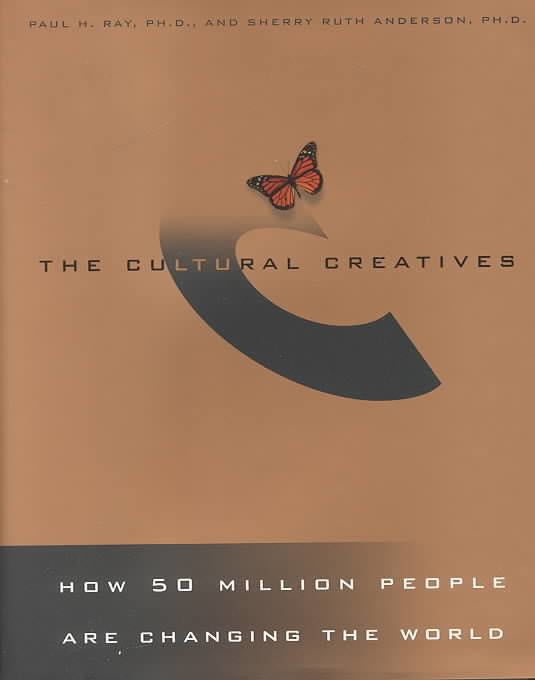Cover artist Whitney Cookman Language English Originally published 2000 Genre Non-fiction | Country United States Publication date 2000 Page count 370 ISBN 9780609604670 | |
 | ||
Similar Sociology books, Non-fiction books | ||
The cultural creatives a hope for a new world
The Cultural Creatives: How 50 Million People Are Changing the World is a nonfiction social sciences and sociology book by sociologist Paul H. Ray and psychologist Sherry Ruth Anderson, first published in 2000. The authors introduced the term "Cultural Creatives" to describe a large segment in Western society who since about 1985 have developed beyond the standard paradigm of modernists or progressives versus traditionalists or conservatives. Ray and Anderson claim to have found 50 million adult Americans (slightly over one quarter of the adult population) can now be identified as belonging to this group. They estimated an additional 80–90 million "Cultural Creatives" exist in Europe as of 2000.
Contents
- The cultural creatives a hope for a new world
- Two types
- Core Cultural Creatives
- Green Cultural Creatives
- Characteristics
- Values
- In business
- Use of the term integral
- References
Two types
Ray and Anderson divide "Cultural Creatives" into two subdivisions:
Core "Cultural Creatives"
Just under half of the CC population comprises the more educated, leading-edge thinkers. This includes many writers, artists, musicians, psychotherapists, alternative health care providers and other professionals. They combine a serious focus on their spirituality with a strong passion for social activism.
Green "Cultural Creatives"
The more secular and extraverted wing of the "Cultural Creatives". They tend to follow the opinions of the core group and have more conventional religious outlooks. Their world views less thought-out than the core group and less intensely held.
Characteristics
Ray and Anderson created a questionnaire to identify "Cultural Creatives" in Western society. The below characteristics were identified as qualities of a "Cultural Creative". Agreement with 10 or more indicates status as a "Cultural Creative".
Values
Ray and Anderson assert "values are the best single predictor of real behavior". The list below outlines the values dictating a "Cultural Creative"'s behavior:
Core "Cultural Creatives" also value altruism, self-actualization, and spirituality.
In business
The concept of "innerpreneurs" to denote persons who create a business that focuses mainly on their own inner goals and development was first introduced by Rebecca Maddox in her 1996 book Inc. Your Dreams The "innerpreneurs" concept is also central to Ron Rentel's 2008 book Karma Queens, Geek Gods and Innerpreneurs, in which he identified the "Cultural Creative" subculture in entrepreneurship. Rentel named entrepreneurial "Cultural Creatives", "innerpreneurs". "Innerpreneurs" have the defining characteristics of an entrepreneur:
But while entrepreneurs use their business for monetary gain, "innerpreneurs" use their business to find personal fulfillment (creatively, spiritually, emotionally) and create social change.
In 2008, there was much discussion in the Western media on the ‘creative economy’ and the importance of the ‘creative class’. Richard Florida published a series of books on this identified 'creative class' and their upcoming economic importance. Bill Gates spoke at the World Economic Forum 2008 on the need for ‘creative capitalism’ as a solution to the world’s problems. They theorize that being creative and inventive will be the key to business success in the 21st century and that a country’s economic success will be determined by its capitalists' ability to mobilize, attract and retain human creative talent. See Douglas Rushkoff for an update on how this evolved.
Use of the term integral
Ray gives the term "Integral Culture" to the growing subculture. He also refers to this as transmodernism, which he refers to as the "Cultural Creatives". They are concerned with ecological sustainability and in the case of a core group have a commitment to personal and spiritual development. These are individuals who can meld the best of traditionalism and modernism to create a new synthesis, having a cognitive style based on synthesizing varied information from many sources into a big picture. This term can also apply to integral theory, a conceptual framework expounded by Ken Wilber.
